The first people to live in Mexico arrived 20,000 years ago. They were nomadic hunters who crossed the Bering Straits from Asia during the Ice Age when the continents were still connected. By 5000 B.C. the first settlers who lived in the valleys and coastal plains began to cultivate maize, beans, and pumpkins. This was also the beginnings of technological and artistic development. Different tribes traveled across the country such as the Olmec, who influenced the spread of civilization. With time other Indian cultures emerged such as the Maya and Zapotecs along with others. For hundreds of years Indian empires rose and fell, until finally the Aztecs founded their capital in Tenochitlan in 1325 A.D. the site of modern day Mexico City.
In 1519, a Spanish conquistador under the Spanish Crown landed in Vera
Cruz, which he would claim for Spain. It was then that he set out
to conquer the much feared Aztec empire which he intended to claim for
the Spanish crown. Cortezí entrance into the empire was ironically
facilitated by the superstitious and religious Aztec ruler Moctezuma.
Moctezuma was anxiously awaiting the return of the Aztec God Quetzalcoatl, or
Feathered Serpent, of whom he had been informed was roaming the area.
When Hernan Cortez appeared before the Aztec emperor he resembled the white
skinned, blue eye god in divine apparel which the ruler had been awaiting
all his life. Mounted a horse, which was foreign to the Aztecs, Cortez
appeared to half man half animal to the Aztecs backed by an army of followers.
Moctezuma would not hesitate to welcome the god who would later turn out
to be only a man, who successfully destroyed more than half of the Indian
population, and rule them for next three hundred years. On September
15, 1810 a Mexican priest by the name of Miguel Hidalgo y Costilla would
lead the Mexican Independence by the accompaniment of a clanging church
bell and his parishioners together with revolutionaries would fight for
their freedom. On September 1821 Mexico was officially declared independent
from Spain.
THE EMERGENCE OF MEXICAN CULTURE
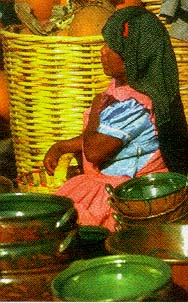
The Mexican population of today is predominately formed of Spanish
and Indian blood. Today, both influences are what make up the Mexican culture.
The people take pride in their heritage, and still carry the traditions
of their Spanish and Indian ancestors into the new culture that arose from
the two: Mexican. A rich variety of foods, words, names, celebrations
such as the Day of the Dead, and other cultural characteristics have been
transferred from the Indian culture to Mexican culture. The Spanish
left major impacts such as the Catholic religion and the Spanish language.
The first universities in the Americaís, the first printing presses, and
the first operas and theaters were all established by the Spanish.
THE PEOPLE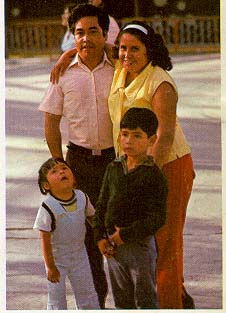
The Mexican people are a vibrant and mixed group. The great majority,
or 75% of Mexicans are mestizos, mixed Indian and Spanish blood while the
pure Indian groups make up only 15% of the total population. The
smallest group of the population are of European, or Spanish ancestry.
Mexicoís social class is distinct and very apparent to the visitor.
It has a large middle class compared to other Latin American countries;
engineers, technicians, managers,merchants, and professionals compose the
middle class. Industrialists and wealthy politicians are members
of the upper class while city workers along with peasants make up the large
lower class. The contrast between the small enormously rich, upper class
and the very poor exemplifies the uneven distribution of wealth and social
progress. It is estimated that 60-70% of the population is
poorly fed and undernourished. About 20% of urban dwellers enjoy
a modest living while the rest live on or below the poverty level.
HOUSING AND FAMILY
A middle class family of four lives on about $250 a month all over Mexico. They probably rent a two bedroom apartment and have one car. Others live in middle class homes that are constructed of adobe and then plastered. A red-tile or corrugated roof covers the structure and the outside is brightly painted. Most homes have tile in the interior of the home instead of carpet. The home usually has a patio as well. Housing styles vary by region. Despite their economic progress, Mexicans must still struggle to keep up with inflation, and the absence of, or struggling infrastructure that provides basic urban services that they must provide for themselves.
Mexicoís population growth has brought about a crisis in the
urban housing market in that there is an absence of affordable housing
and housing units in general. The cities cannot provide employment
or urban services for older residents, nonetheless for a mass of new comers.
Many of those who migrate to the city seek to escape poverty in rural villages,
but come to meet with it once again in the urban city. Striking signs of
poverty are evident in the expansion of slums, and the development of squatter
settlements otherwise known as illegal shantytowns or squatter settlements.
In Mexico they are referred to as lost cities, ìciudades perdidasî,
or colonias proletariat. Many of these settlements lack basic urban
services such as running water, electricity, refuse disposals, sewers and
roads. Despite their illegal tenure, authorities tolerate these settlements
because of the tremendous housing shortage. Government statistics
indicate that millions of Mexican families lack decent housing. Many
live in shantytowns or squatte settlements where homes are built from scraps,
leftover lumber, cardboard and other available materials. The Habitat
organization has built 7,200 homes in Mexico where homeowners sign a mortgage
agreement of a ten year maximum. Houses built by habitat are made
of cement block walls, poured concrete roofs, and they average 450 square
feet. The families who purchase these homes work in the construction
of their homes as well as in other communities where houses are being built.
Organizations such as Habitat For Humanity International recognize Mexicoís
enormous housing deficit and set out to provide decent housing for people
all around the world.
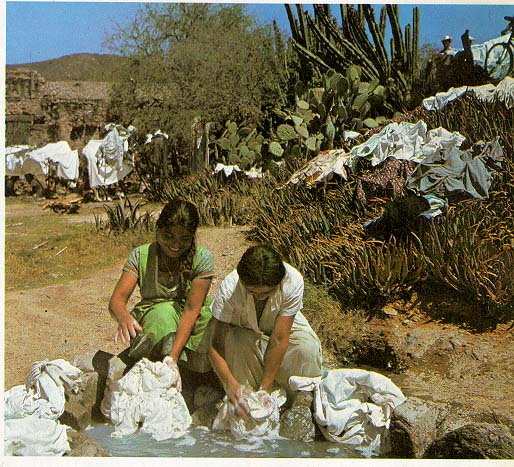
Economic contributions are made by every member of the
family in lower-class Mexican society. Those who do not have a permanent
employment hire themselves out day by day, or by doing odd jobs.
Women often work in domestic services for the middle or upper classes.
Children also work, usually selling candies, arts & crafts in the central
market, in nearby grocery stores as bag boys/bag girls, or sometimes assisting
at the family food stand. Every member of the household contributes
to the livelihood of the unit. Parental authority is very strong,
as well as kinship with the men as the dominant figures. Extended
families are not uncommon in Mexico which facilitate the provision of shelter
and food by a greater contribution base. Families still practice a ritual
of many centuries by adopting godparents for their children. The godparents
serve as role models and possible guardians, and also sponsor ceremonial
events in the childís life such as baptisms.
EDUCATION

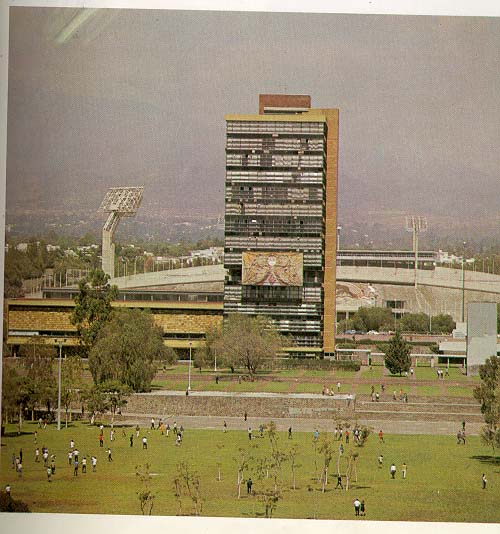
Mexico has a total of 25 million schoolchidren. Mexico spends twice
as much on education as defense. About 18 million are in primary
education (6-14 years old), 6 million are in the following 3 years of education,
prearatoria (15-19 years old), and 1.5 are in higher education (19-24 years
old). Since the 1920ís Mexico has engaged in literacy campaigns and
has brought illiteracy down to less than 15%.
Unfortunately, almost half the children leave school before the end
of the sixth year in school because they must go out to work.
RELIGIOUS SOCIETY
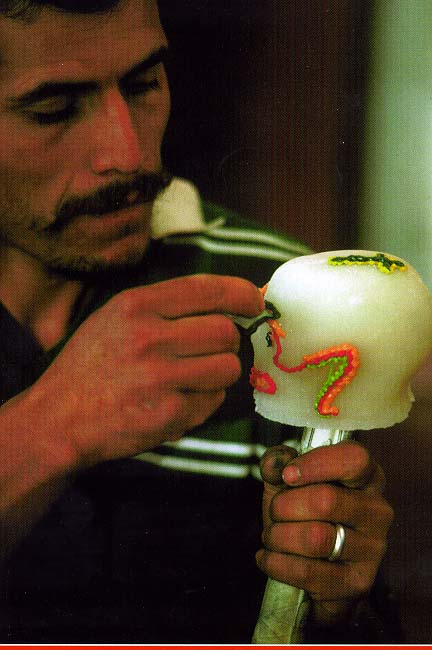
A fundamental part of Mexican culture is religion. Indian tribes consisted of religious cults that worshipped many gods, and with the arrival of the Spanish came Christianity. Though Catholicism was forced upon the Indians, they still practiced native religious rituals by synchronizing both religions. In Mexico patron saints and Virgins are worshipped on their anniversaries and celebrated with rituals as in ancient times. The Christian religion has merged with that of the pagan,which is widely evident by one of the most celebrated holidays in Mexico known as Dia de Los Muertos, Day of the Dead. This is celebrated November 1 and 2. This holiday is based on the belief that the dead are permitted to visit their living kin, thus allowing the living to express their love by setting up alters at home, or at the deceased grave site with candles, pictures, marigold flowers, as well as the deadís favorite dishes, preferred bottle of liquor, and other preferenceís such as cigaretteís, books, etc. The country prepares for this holiday by selling pan de muerto, bread of the dead, candy skeletons and skulls, and towns explode with food,drinks and parades with mock coffins. This celebration embraces death as an inevitable factor of life. Other major celebrations throughout Mexico include Dia de los Reyes (children leave shoes in front of the door to be filled with sweets and toys, Jan. 6th), Semana Santa (Holy week/Easter), 5 de mayo (Annivesary of victorious battle against France), Dia de la Independencia, (Independence Day, Sept. 16), Dia de la Virgen de Guadalupe (Feast of the Virgin of Guadalupe Dec. 12), and the Posadas ( Processions of Mary and Josephís journey to Bethlehem Dec. 16-24) and Navidad (Christmas Dec.25).
LEISURE
Recreation in Mexican culture is found in the popular sports of soccer and baseball. Family gatherings with friends, and lots of food and plenty of spirits, as well as music is a form of weekend celebration as well as entertainment. Television in Mexico is also a major form of entertainment. Television aerials are highly visible even in the poorest towns. Bars, cafes, and some restaurants have television sets for their customers to watch. Telenovelas, or soap operas are enjoyed by every family member. The most common theme is class differences with good lower-class characters and evil upper-class counterparts with an unhappy ending for the lower class characters which probably reflects the economic situation for most viewers of telenovelas. Most investment is made on the production of Telenovelas than on movie productions.
MUSIC
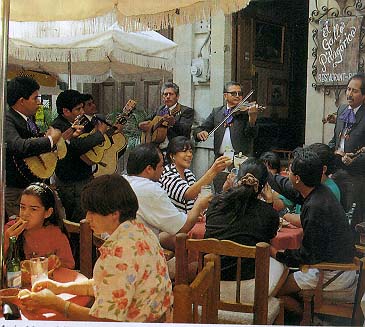
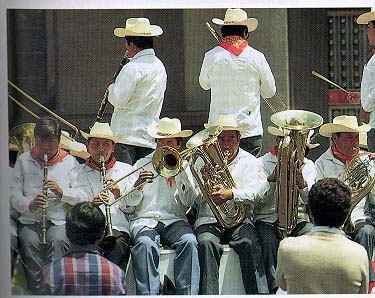
Music is essential in the Mexican culture. It is always included in celebrations and other important events. Telenovelas (soap opera) usually have sound tracks and a hit pop song as the theme sung by popular pop singers. Sometimes the bands or pop singer is featured in one scene or throughout the soap opera.
The most distinctive music of Mexico is the sound of the Mariachis. Mariachis bands consists of guitars, violins, and trumpets. The mariachi costume is referred to as a charro, or fancy dressed Mexican cowboy with tight fitting pants lined with silver buttons a wide brimmed sombrero and boots. They are customarily hired to play at weddings, birthdays, and other special events.
Nortenas and Rancheras are ballads that tell stories/tales about thieves, drug runners, and other stories about the working and lower class citizens. The sound is much like the typical tune of the polka with the accordion being the main instrument.
Bandas are large brass and percussion bands that play a variety of songs with an emphasis on the brass instruments.
Cumbia, is a seductive music which was imported and adopted from the Carribean. The songs are very distinguished by their flirtatious double meaning lyrics.
FIESTAS, FOOD AND DRINKS
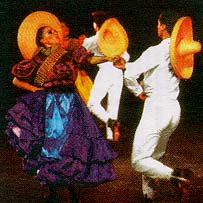
Celebration in Mexico are known as Fiestas. Fiestas range from observing national holidays, to a townís patron saintís day, weddings, birthdayís, a visit from a relative or friend, and just about anything or accomplishment that is worthy of celebration. Fiestas usually include music, dancing, plenty of food and drinks, cakes and other sweets, and of course a candy filled pinata for the children.
Authentic Mexican food has many influences including Maya, Aztec, and
Spanish. Squash, beans, and corn are still the basic food items as
they were to the Aztecs. The Spanish added rice, sugar, cattle, pigs,
goats and chicken to the food items. Both influences make up the
Mexican cuisine. Corn anchors the Mexican diet. The corn tortilla
in Mexico is equivalent to eating bread in other cultures, and it is ever
present in practically every meal as well as chile. There are many
typical and popular foods such as tacos that are rolled tortillas filled
with meat, beans or cheese;when tacos are fried they are called taquitos.
Tostadas are fried tortillas with minced meat, chicken,beans, lettuce,
cheese and chile. Tamales are a mixture of corn filled with
bits of spicy meat or pork individually wrapped in corn husks. National
favorites include mole which is a chocolate sauce with chiles, many spices
and nuts simmered in turkey or chicken. Carne Asada is another national
favorite, it is grilled beef marinated in citric juices, garlic, and
salt. Not surprising, they are served with a side of tortillas, as
well as beans and rice.

Mexicans begin their day with coffee. Cafe de olla is coffee flavored with cinnamon and sugar. Coffee is also served with milk, usually evaprated milk. Most Mexican people enjoy and prefer cafe con leche is strong black coffee and hot milk combined. Another favorite is hot chocolate which is not as sweet as American hot chocolate.
A licuado is a fruit shake that is made with bananas or papaya. Coca-cola is also enjoyed by many as well as bottled mineral waters.
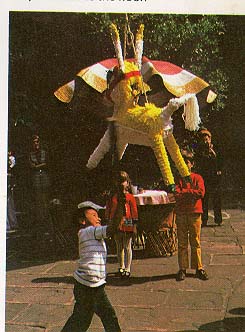
Despite the fact that Mexico is a Third World country it is a country filled with rich culture that centers itself around the traditions of its indigenous and Spanish ancestry
BIBLIOGRAPHY
Mexicoís Dream - The great Mexican dream
http://www.Nafta.net/mex.biz/articles/dream.htm
Habitat for Humanity International:
http://www.habitat.org/intl/
Mexico Connect:
http://www.mexconnect.com/mex-/stevi1.html
Statistical Overview of Mexico: CIA World Fact Book
http://www.public.iaste.edu./~rjsalvad/scmfaq/mexstat.html
Meyer, M. & Sherman, W.L. (1991). Mexican History. New York, Oxford University Press
Sayer, C.(1990). Arts and Crafts of Mexico. San Francisco: Chronical Books
Peoples of the World-Latin Americans
Mexico TravelBook
Published by: AAA Publishing 1997
Mexico Baedeker Travel Guides 1998
Howells, J. (1989). Travel In Mexico. Gateway Books: San Francisco
Firth, L. (1976). Mexico: The land and its people. Macdonald Educatinal Ltd.: London
Ryskamp, G. & Ryskamp, P. (1996). A Studentís Guide to Mexican American Genealogy. The Oryx Press: Phoenix, Arizona.
This page was created by Dolores Robles as part of the requirements for FCS428 International Housing in the Spring of 1998 at California State University, Long Beach.
![]() ©1998
- This page was developed in electronic form and made available on-line
by: Dr.
Lydia Sondhi, Family and Consumer Sciences, California State University,
Long Beach
©1998
- This page was developed in electronic form and made available on-line
by: Dr.
Lydia Sondhi, Family and Consumer Sciences, California State University,
Long Beach
last updated: 06/01/98
 MEXICO
MEXICO